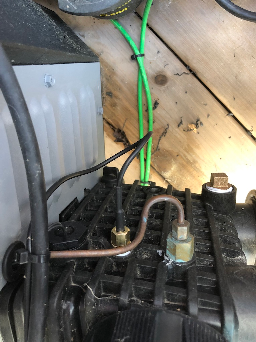...
From this UI, you can set the WIFI SSID and password for your network. Once it reboots again, you can log into it via http://pool-heater.local/. If that doesn't work, you'll have to find it in your network. Check your router to see if you can find it.
From this UI, you can set the water temperature, mode and units.
This firmware also This custom firmware has a MQTT configuration allowing it to integrate with homebridge. (Requires an MQTT server)
Homebridge Configuration
Using the mqtt-thing homebridge plugin, add the following configuration:
...
- Use the dimple to center the drill bit. Drill a 1/4 in (6.4 mm) diameter hole through the port. Take care not to damage the plastic threads. TIP: Drilling a 1/8 in (3 mm) diameter hole first will help prevent thread damage
- Wrapped 5-6 turns of PTFE (Teflon) tape around the male threads of the adaptor.
- Thread in your 1/4 inch adaptor into the port. Make sure to get a snug fit. Do not over-tighten.
Homebridge Configuration
...
| Code Block |
|---|
{
"accessory": "mqttthing",
"type": "thermostat",
"name": "pool-heater",
"url": "http://192.168.1.50:1883",
"username": "homebridge",
"password": "pass",
"topics":
{
"getCurrentTemperature": {
"topic": "pool-heater/status",
"apply": "return JSON.parse(message).temperature_f;"
},
"getTargetTemperature":{
"topic": "pool-heater/status",
"apply": "return JSON.parse(message).tarTemperature_f;"
},
"getTemperatureDisplayUnits":{
"topic": "pool-heater/status",
"apply": "return 0;"
},
"getCurrentHeatingCoolingState":{
"topic": "pool-heater/status",
"apply": "return JSON.parse(message).state;"
},
"getTargetHeatingCoolingState":{
"topic": "pool-heater/status",
"apply": "return JSON.parse(message).mode;"
},
"setTargetTemperature": {
"topic": "pool-heater/command",
"apply": "return 'setTemp ' + message;"
},
"setTargetHeatingCoolingState": {
"topic": "pool-heater/command",
"apply": "return 'mode ' + message;"
},
"setTemperatureDisplayUnits": {
"topic": "pool-heater/command",
"apply": "return 'tempUnits ' + message;"
}
},
"heatingCoolingStateValues": ["0","1"],
"temperatureDisplayUnitsValues": [0,1],
"minTemperature": 60,
"maxTemperature": 100
}, |
In the Apple Home App we now have access to our pool heater.
...
References
| Reference | URL |
|---|---|
| Jandy Heater Manuals | https://www.jandy.com/en/products/heaters/jxi Installation: https://www.jandy.com/-/media/zodiac/global/downloads/h/h0574300.pdf Installation Code Handbook: http://www.tagengineering.ca/wp-content/uploads/2015/02/B149-1handbook.pdf |
...

